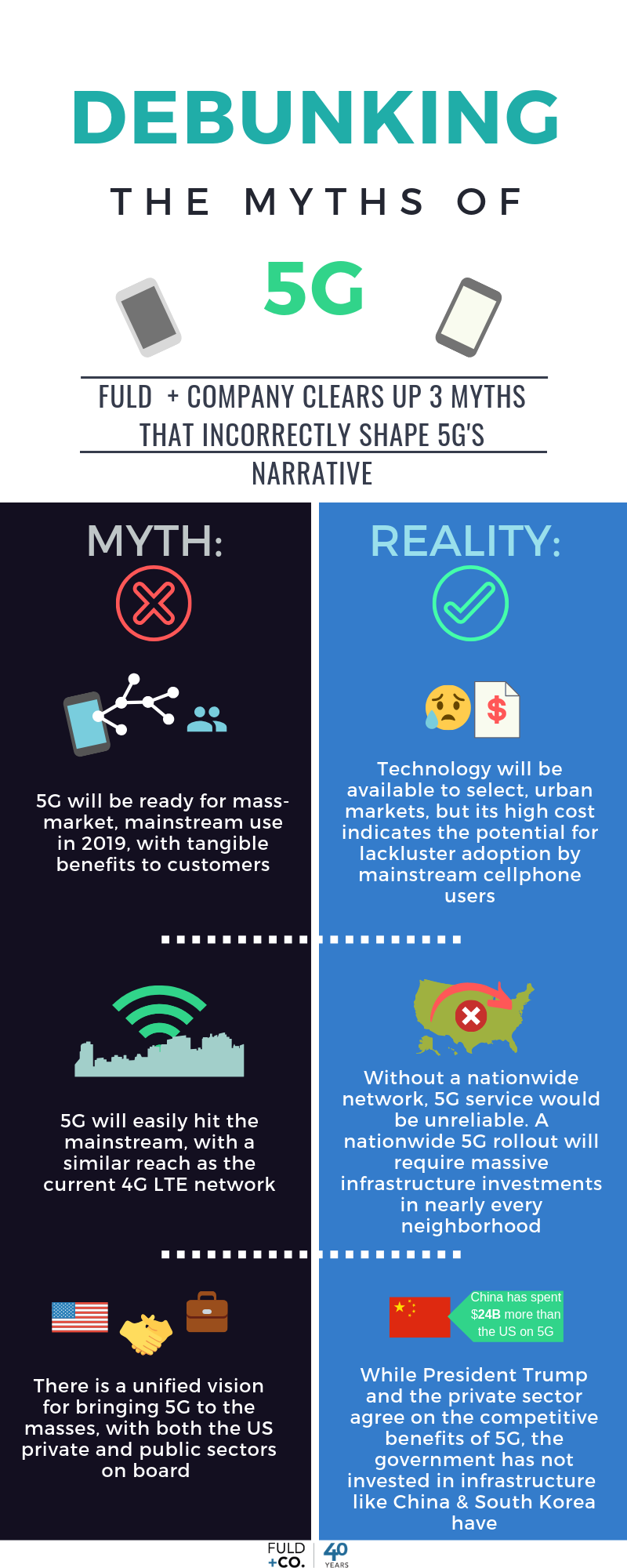Why Strategic Business Leaders Should Question Fifth Generation Technology’s Readiness
Posted by | Fuld & Company
We Debunk 3 Popular Myths Amidst an International Race to 5G
As the pace of disruption increases, Fuld & Company acutely monitors disruptors with the power to upend a variety of industries, especially those that bring immense transformation on a global scale. While most believe groundbreaking innovations have the potential to cause global disruption, the truth is, there are a lot of factors for the public to consider before determining global disruption will take place.
Typically, the public perceives disruption as change caused by technology, and while technology will always threaten the status quo, there are few technologies that promise to single-handedly change the way we communicate, the way we drive and the way we approach healthcare—that is, until 5G entered the marketplace. Certainly, a technology of this caliber causes a lot of confusion and eagerness, but it’s important to take an objective critical look at 5G, today.
While fifth generation (5G) technology’s potential has many business leaders excited, there are several political, regulatory and infrastructure issues creating hurdles to its widespread adoption, all of which Fuld & Company experts are watching closely.
Still, in the midst of a race to 5G, difficult to discern how far away the US is from rolling out 5G on a national scale because both the headlines and large telcos alike lead us to believe 5G is either already here or on its way in the near future. Adding further complexities to the conversation, the ubiquity of 5G discussion is causing an international 5G race between the US and China for adoption, increasing the pressure to develop 5G networks nationally. While these activities serve to accelerate the public’s perception of 5G’s readiness, it is important for companies not to assume the technology is currently revolutionizing the larger digital ecosystem, right now.
To gain more background on the topic, we sent Senior Consultant, Ray Tetreault, to CES 2019 which broadly highlighted advancements in 5G technology. There, we were able to get a more accurate feel for how the market is reacting to the buzz.
As a result, we gained a firmer understanding of the current landscape and took a closer look at where 5G’s development stands now, and how it will be implemented nationwide.
Our suspicion about 5G’s readiness was confirmed: even though 5G has the potential to disrupt several industries at once by bringing us autonomous vehicle networks, smart cities, and more robust Internet of Things (IOT) development, it’s still in its nascent stages and has a long way to go before we see widespread coverage. So, before players jump on the 5G bandwagon and begin investing heavily— there are a few myths that need to be put to rest.
What is 5G? Technology that boasts faster speeds than 4G LTE, higher connectivity and added capabilities for interacting with intricate networks on mobile devices

Despite the fact that these myths aren’t rooted in reality, the large telcos have issued many buzzworthy communications pieces designed to spur hype and serve as provocative advertisements. For example, AT&T recently landed in hot-water for branding a new service as “5GE” even though it was still using the company’s 4G LTE network. AT&T claims the ‘E’ stands for ‘Evolution’, and that it did not intend to mislead customers into believing they were getting access to 5G speeds and service on their devices; but their competitor Sprint felt differently and responded with a lawsuit for false advertising.

Image sourced from The Verge | AT&T via FierceWireless
As of now, it’s clear to us that the general public may be so focused on increased connectivity that they are unaware of the pending massive infrastructure development that needs to happen and therefore anticipating 5G’s deployment, incorrectly.
That said, even though 5G has unyielding potential to bring us dramatic positive change, it is clear to us that strategic companies should avoid getting distracted by the technology’s future possibilities. Understanding how and when the technology is likely to impact a specific market will allow businesses to better prepare for a variety of different outcomes. This can be done by monitoring external drivers and planning for potential scenarios without needing to play guessing games, or by conducting a workshop to create a clearer plan for the future. As the race to 5G intensifies, it’s even more critical to have a future-focused action plan.
So, for now, it’s wise for business leaders to logically evaluate the 5G landscape and not engage in faulty promises delivered by clever advertisers. While it’s true 5G will bring tremendous opportunities, much of the hoopla is simply a bunch of noise designed to spur publicity. Myths aside,someone will win the 5G race and real 5G coverage will come and disrupt—it’s just a matter of pinpointing when. Simply put, identifying its rollout, and formulating a strategy to proactively greet the disruption with the help of a 3rd party, is invaluable.
Check back to Fuld & Company’s blog where we’ll continue to fuel the 5G discussion, cover the 5G race and provide our in-depth analysis on the technology’s impact across industries. And, for more information on 5G myths in the marketplace, please contact us at info@fuld.com
Tags: 5G, China, Competitive Advantage, Information Technology, New Entrant Strategy, Other Industries



















